How Exposure Management Will Reshape Cybersecurity
Five paradigm shifts to guide your strategy
1.
The concept of “attack surface” will significantly broaden.
2.
Organizations will shift towards an all-encompassing view of cybersecurity risk.
3.
Cybersecurity risk will transition from subjective to objective evaluation.
4.
C-suite executives will prioritize informed cybersecurity management decisions.
5.
Cybersecurity strategy will guide operational investments.
The concept of exposure management is emerging as a transformative force in cybersecurity. Unlike conventional methods that often view risk in isolation, exposure management encourages a contextual understanding of threats, situating them within a broader framework of business objectives. This shift is not merely a change in perspective; it’s a foundational reimagining of how businesses approach security.
The threats facing organizations today will only continue to grow in number and complexity, demanding commensurate growth in how organizations conceive of cyber risk. No longer can security be siloed within the IT department. Instead, it must be a shared responsibility, with every aspect of the business playing a role in identifying, mitigating and managing risk. This collaborative approach enhances an organization's resilience and serves to foster innovation and drive competitive advantage.
The continued emergence of exposure management has the potential to fundamentally alter the field of cybersecurity and how it’s viewed at a business level. We believe the following five projections are not only possible but likely outcomes of that emergence.

01
The concept of “attack surface” will significantly broaden.
Your organization's attack surface is far from static. It's changing quickly, and the traditional parameters that once defined it — software and hardware — fail to capture a number of key considerations for any modern security strategy.
As the technology that powers today's businesses becomes yet more interconnected, a given company’s attack surface expands along with it. Dynamic elements like cloud environments and third-party vendors introduce unique vulnerabilities that organizations can’t afford to ignore.
Here are some of the elements of the attack surface you might be overlooking.
Take a broader look at your attack surface
Use our editable checklist for a deeper look at the asset categories above and more, as well as the tools you can use to track them.
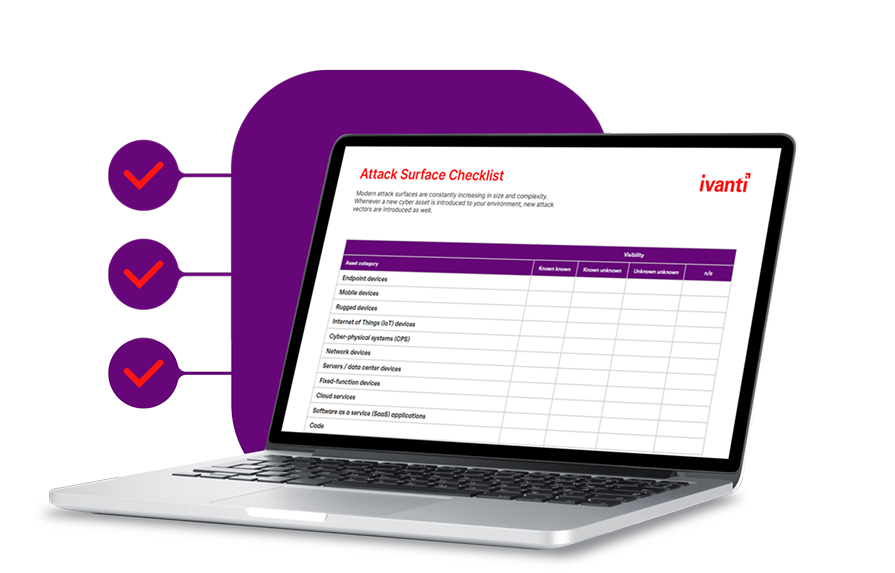

02
Organizations will shift towards an all-encompassing view of cybersecurity risk.
Today, risk management rests largely, if not entirely, with your IT team. It's a siloed discipline, such that its implications for the core business are not properly aligned with how it's treated at an organizational level.
Furthermore, it also often revolves around point products: solutions designed to address specific security threats as they arise, creating a feedback loop of disparate specialization rather than a holistic view of cyber risk. As point products often fail to properly integrate with one another, the gaps in their cooperation can leave resulting gaps in your security coverage.
To step away from that flawed methodology is to consolidate your risk data and pursue a comprehensive, contextual view of cybersecurity risk.
Here are some practical steps you can take towards holistic risk management.
Data Collection
Create a comprehensive inventory of all your cybersecurity tools and platforms in use across the organization. Refer to our Exposure Management Readiness Checklist for examples and help identifying the visibility gaps that you need to close.
Integrated Risk Management
Implement a centralized platform, like an Exposure Assessment Platform (EAP) or Risk-Based Vulnerability Management (RBVM) tool that can use the aggregated asset and exposure data from those tools to determine risk, enabling a unified view of your risk posture.
Strategic Alignment
Develop executive-level reports to provide a concise view of the organization’s risk posture relative to its risk appetite, helping to make cybersecurity a core part of business planning.
Gauge your exposure management readiness
Use our checklist to see where your capabilities stand today and where you have gaps to fill.
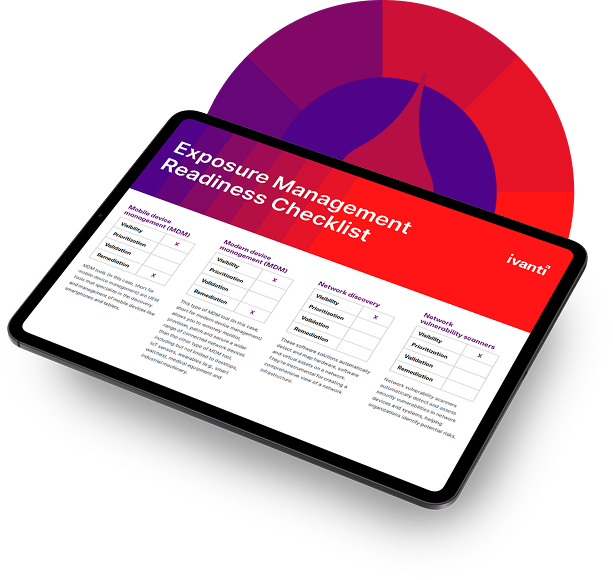

03
Cybersecurity risk will transition from subjective to objective evaluation.
The metrics used by security operations teams today don't effectively translate to strategic planning, owing to a lack of universally accepted standards. While security frameworks and standards provide some guidance, they often focus more on what needs to be done rather than how to do it.
Exposure management will lead to more rigorous measurement of decision-making data, while streamlining the output that ends up in front of executives: actionable, objective information that can guide organizations towards their desired security posture.
These are the steps you can take to get there.
01
Identify In-Scope Assets
Identifying the assets whose compromise would cause the greatest business impact — for example, confidential information or critical business processes — as well as the IT assets on which they rely, focuses your risk assessment on the areas that matter most to your organization.

02
Assign Asset Value
To effectively manage risks associated with your assets, begin by assigning value to each asset. As part of that analysis, use information specific to your organization — like internal data, risk appetite and unique vulnerabilities — versus general market trends.

03
Identify Vulnerabilities and Threats
Identifying the highest-priority threats and vulnerabilities shows you the most likely routes through which your critical assets could be compromised, information that you will layer on top of asset value to quantify risks to your business.

04
Calculate Risks
Next, assess the likelihood of a potential threat event and its impact on your assets to arrive at a data-driven evaluation of your risk level.

05
Perform a Cost-Benefit Analysis
Finally, use your risk assessment to conduct a cost-benefit analysis of mitigation versus acceptance, in line with your organization’s risk tolerance. The continued evolution of machine learning will help drive this transition, making precise, real-time risk assessments available to organizations as they make decisions.

Assess risk objectively

How to Apply Risk Quantification
Read our blog for a deeper explanation of how to make use of quantitative risk assessments.
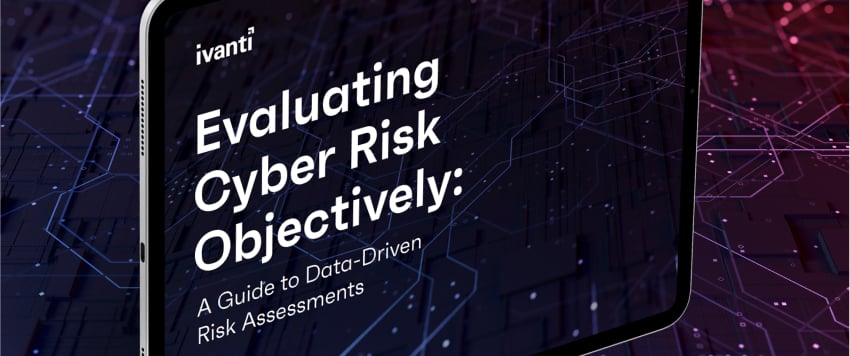
Data-Driven Risk Assessment Guide
For an in-depth resource on conducting a data-driven risk assessment, read our guide.
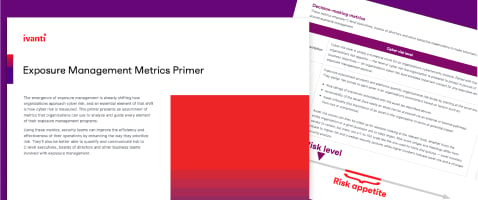
Exposure Management Metrics Primer
To familiarize yourself with the key metrics of exposure management, check out our short guide.

04
C-suite executives will prioritize informed cybersecurity management decisions.
Without shared, legible metrics, cybersecurity risk can’t be properly articulated to the executives tasked with making decisions. It falls to the C-suite to effectively guess at the organization’s security strategy without being able to objectively measure the results.
There are no reliable processes today that provide objectivity and a direct line to data-driven decisions. Integrating cybersecurity into business strategy thus becomes difficult, if not impossible, hindering or preventing a robust assessment of the organization’s risk appetite.
Exposure management will enable C-suite executives to cultivate a core competency in making informed, consistent and explainable cybersecurity risk management decisions. Equipped with robust data and advanced analytics, leaders will be able to situate risk in business terms, facilitating better communication and collaboration across the organization.
Achieving this requires not just new capabilities from vendors, but a change in corporate culture and a willingness to revisit decision-making processes.



Here’s what needs to happen and thoughts on how to approach it.
Establish
Implement
Foster
Communicate
Review
Establish a Risk Appetite Framework
Define the organization's risk appetite and how it aligns with your business objectives, creating a framework to guide decision-making and ensure consistency. Familiarize yourself with the fundamentals of risk appetite, and use our Risk Appetite Statement Template when you're ready to get started.
Implement Advanced Analytics
Measure your progress with the data-driven insights to identify where your risk posture stands relative to your risk appetite. RBVM tools and EAPs can help identify trends and predict threats with a holistic view of the risk landscape.
Foster Cross-Functional Collaboration
Break down silos and encourage collaboration between security, IT and business teams, establishing regular meetings and workshops to align efforts.
Communicate Risk in Business Terms
Support that collaboration with a shared language and legible metrics. By translating cyber risk into potential business impact, like the projected revenue loss caused by a data breach, you allow a variety of stakeholders to better engage.
Regularly Review and Adapt
Make informed decision-making an ongoing process. Continuously review risks, controls and assumptions to adapt to the evolving threat landscape. With the C-suite both informed and engaged, cybersecurity risk can take on a deservedly larger role in business-level decision-making, much of which can be driven by the data we covered above.





Get informed on risk appetite

Understanding Risk Appetite
Read our blog to get up to speed on the fundamentals of risk appetite.

Risk Appetite Statement Template
Use our editable template to make your own risk appetite statement and put it into action.

05
Cybersecurity strategy will guide operational investments.
Today, cybersecurity is primarily managed by technical specialists who often struggle to effectively communicate their needs to the C-suite. At the same time, while executives are fully aware of the critical importance of cybersecurity, and the risks associated with neglecting it, they aren’t always equipped to bridge the knowledge gap between them and their IT/security teams.
This disconnect makes it challenging for any organization to define what constitutes a ‘good’ and ‘reasonable’ cybersecurity budget or strategy. As a result, decisions are too often made on the basis of fear or industry trends rather than informed judgment. That approach introduces misaligned priorities, inefficient resource allocation and a lack of accountability. Taken together, even an organization that believes it’s taking the right steps to protect itself can fail to do so.
To meet these challenges, organizations should implement a strategic approach to cybersecurity, measuring operational priorities against performance data.
Align your cybersecurity strategy
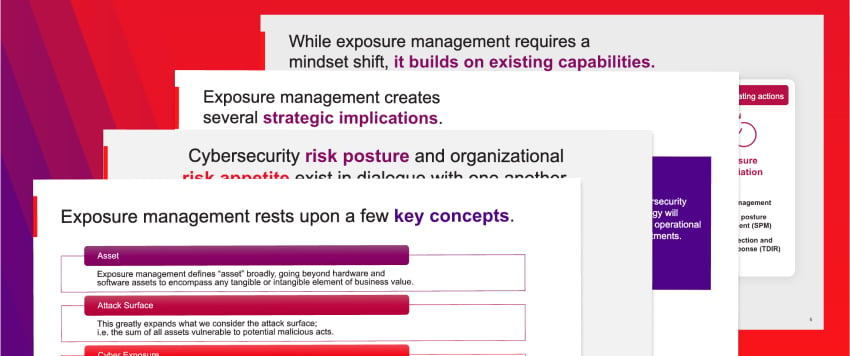
Exposure Management Explainer Slides
Use our editable slide deck to introduce stakeholders to the key concepts of exposure management.
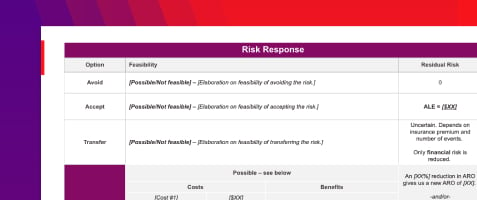
Risk Assessment Reporting Template
Use our editable slide template to report on risk assessment findings and recommendations.
Shift your security strategy
As exposure management continues to take firmer shape, the five paradigm shifts listed above carry sweeping implications for cybersecurity as a market, as a field of practice and as a strategic business objective.
Equip yourself for these shifts with Ivanti’s exposure management solution, which combines external attack surface management, risk-based vulnerability management and exposure remediation capabilities to help you proactively secure your environment.